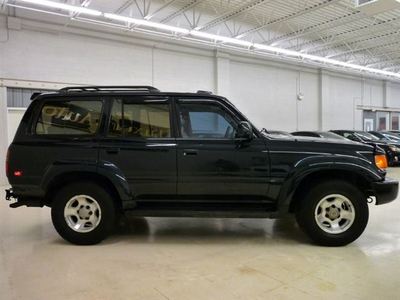Feature Story
COLLECTIBLE TOYOTA LAND CRUISER
by Bob Hagin
July 5, 1996
The '96 Toyota Land Cruiser and its Lexus LX 450 clone are definitely not off-road roughnecks. With air conditioning for both front and rear passengers, a fancy CD sound system and all the amenities of carriage-trade luxury cars, they are more at home in country club parking lots than the wilds of California's Sierra Nevada mountains or the rocky trails through the Black Hills of South Dakota.
But like many of the members of today's classy upper-crust, the Land Cruiser has ancestry that includes some very tough 4X4 pioneers. In 1951, one of the prototypes (then known by the code name Model BJ) was the first motor vehicle to climb to the sixth station of Mt. Fuji and the company made much of the fact in its world-wide advertising.
Like its British counterpart, Rover, this kind of a reputation was important to Toyota because the goal of the Land Cruiser as well as the Land Rover was to out-Jeep the Willys Jeep.
But somewhere along the line the Land Cruiser (by then dubbed the Series 40) developed an off-beat reputation and a following in this country that far outstripped any of the other Jeep challengers. Maybe it had something to do with fact that the original 85 horsepower diesel engine was replaced in 1955 with a 3.8 liter gasoline powered six-banger that looked strangely familiar to American G.Is stationed in Japan. And well it should since it was the veteran Chevrolet "Stove-Bolt Six" that was found in many new Chevys of that era.
When the Land Cruiser was offered for sale by American Toyota dealers in this country in 1960, it wasn't long before a couple of things dawned on American hot-rod enthusiasts. The first was that speed equipment suitable for the six cylinder Chevrolet engine was applicable to the homely Japanese off-roader. The other was that without much modification to the engine bay and running gear, the legendary small-block Chevy V8 could be slipped in with lots of room to spare.
This ease of interchangeability has lead to the formation of a network of Land Cruiser owners that's truly a phenomena. The V8s are pumped up to who-knows-how-much horsepower and the "Stove Bolt Sixes" are likewise given a dose of bolt-on steroids. The chassis are strengthened to rival the structural rigidity of a tank and the suspensions are raised high enough to provide ground clearance for a racing go-kart to slip under at top speed. Roll-over cages are attached that rival a suspension bridge in complexity and oversized "knobby" tires are installed that might allow the vehicle to climb up the slightly-tapered side of the Transamerica Building in San Francisco.
And lest you think that these modifications are strictly cosmetic like the "boy-racer" 4X4 raised pickups that annoy us by putting their headlights directly into our back windows at a stop light on dark evenings, a quick perusal of photos of the bi-monthly "Toyota Trails" (Toyota Land Cruiser Association) magazine proves otherwise. It seems that family outings put on by member clubs are held in the most difficult, rock-cluttered terrain imaginable. All of the vehicles are equipped with bumper-mounted winches and pulling each other out of impenetrable quagmires is a common occurrence.
All this information comes to me from a family source. My son Matt is a dyed-in-the-wool Land Cruiser aficionado and is deep into a total restoration and modification of his third Series 40. I have learned that there is a plethora of original equipment and aftermarket parts available for the Series 40 Land Cruiser from the factory and independent specialty shops that range from original equipment repair parts for the transfer case to replacement bodies made of aluminum.
I recently helped Matt transport his stripped Land Cruiser chassis to a shop in the California gold country that specializes in modifying them for extremely rough off-road service. Owner Danny Warden told me his Land Cruiser business has been in operation since 1972 and that he had taken over from his father when he retired. Warden's business is one of several around the country that specialize in modifying these big Toyotas.
Off-road clubs are very similar to sports car clubs of 40 years ago and Land Cruiser owners have formed chapters of the Toyota Land Cruiser Association in towns in Pennsylvania, Georgia, Utah, New Jersey, California and most other states. All are family-oriented, friendly and quite happy to welcome new members.
The original flat-fendered Series 40 went out of production in 1983, its place in the Toyota line-up taken by a succession of Land Cruisers that became more and more luxurious and "trendy." Hard-core off-roaders lament this turn of events and claim that the newest version isn't up to the name. But I'm not so sure.
It just may be that owners of new Toyota Land Cruisers and Lexus LX 450s aren't too anxious to put their $45,000 investments through the trials and tribulations of our boulder-strewn wilderness.



